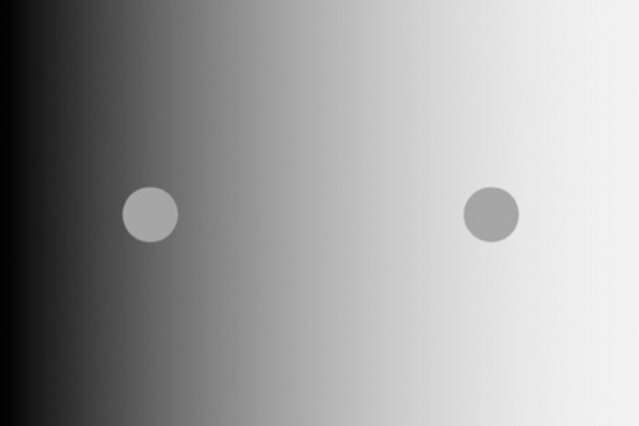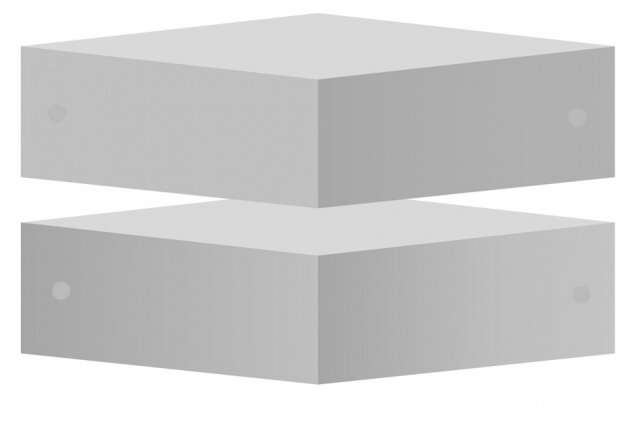Study sheds light on a classic visual illusion

It's a classic visual illusion: Two gray dots appear on a background that consists of a gradient from light gray to black. Although the two dots are identical, they appear very different based on where they are placed against the background.
17 Jun 2020--Scientists who study the brain have been trying to figure out the mechanism behind this illusion, known as simultaneous brightness contrast, for more than 100 years. An MIT-led study now suggests that this phenomenon relies on brightness estimation that takes place before visual information reaches the brain's visual cortex, possibly within the retina.
"All of our experiments point to the conclusion that this is a low-level phenomenon," says Pawan Sinha, a professor of vision and computational neuroscience in MIT's Department of Brain and Cognitive Sciences. "The results help answer the question of what is the mechanism that underlies this very fundamental process of brightness estimation, which is a building block of many other kinds of visual analyses."
As one part of their investigation, the researchers studied blind children in India and found that they were susceptible to this illusion almost immediately after their sight was initiated after surgery, offering further evidence that brightness estimations are likely based on simple neural circuitry that doesn't require any prior visual experience to be set up.
Sinha is the senior author of the study, which appears in the August issue of Vision Research. Other authors of the paper are Sarah Crucilla, who worked with Sinha while she was in high school and is now a Caltech undergraduate; Tapan Gandhi, a faculty member at the Indian Institute of Technology and a former postdoc at MIT; Dylan Rose, a recent Northeastern University Ph.D. recipient; Amy Singh of Google, who is also a former MIT postdoc; Suma Ganesh and Umang Mathur of Dr. Shroff's Charity Eye Hospital in New Delhi; and Peter Bex, a professor of psychology at Northeastern University.
Estimating brightness
When we look at an image, our brain perceives a certain brightness at each location of the image. Surprisingly, however, our brightness percepts are not always proportional to the amount of light emanating from image regions, Sinha says. Instead, our perception is the product of the object's actual color and the amount of light that is shining on it.
"You could have a really dark piece of cloth under a bright spotlight, and the amount of light that you get from it could be the same as, or even more than, the amount of light from a white piece of paper under dim light," Sinha says. "The brain is presented with the challenge of figuring out how light or dark a surface is based on just the amount of energy it's receiving. In essence, the brain has to figure out the two numbers that were multiplied (illumination level and surface darkness) to produce the one number it is receiving (incoming energy)—a seemingly impossible task since infinitely many pairs of numbers can all yield the same product."
Some scientists, including the 19th century German physicist Hermann von Helmholtz, an early pioneer of vision studies, suggested that estimating brightness is a "high-level" process. That is, the brain estimates brightness based on a high-level understanding of the lighting conditions, shapes, and shadows in the environment that it's seeing.
Many visual tasks, such as identifying faces or objects, do rely on our previous experiences or expectations about what we're seeing. However, the experiments that Sinha and his colleagues performed in this study suggest that in the case of brightness estimation, high-level processing does not play a significant role.

In their first set of experiments, the researchers created an image of a cube that appeared to be lit from the side, with one face appearing a little brighter than the other. In reality, using a clever trick that Chinese ceramic painters knew over 800 years ago, the face that looked brighter actually had lower luminance than the face that looked darker. In this display, the researchers found that when identical gray dots were placed on the two cube faces, the dot that was on the face that seemed to be in shadow actually appeared darker than an identical dot placed on a face that was receiving more light.
"This is the opposite of what happens in standard simultaneous contrast displays, in which a dot on a dark background appears brighter than a dot on a light background," Sinha says. "This result runs counter to the idea that high-level analysis of lighting conditions contributes to brightness estimation."
The second set of experiments was designed to localize the processes of brightness estimation. It built on the curious fact that the unified view of the world we experience, constructed by merging images from the two eyes, is accompanied by an almost complete loss of "eye of origin" information. We do not know what the original images were, and which eye they came from; we are only aware of the merged view (sometimes called the "cyclopean" image, after the one-eyed monster Cyclops of Greek mythology). However, using specially designed images and stereo glasses, the researchers found that brightness estimation did not need to wait until information from the two eyes was merged; it had already occurred by that point.
This finding suggests that brightness estimation occurs very early, before information coming from each eye is combined into one visual stream. The combination occurs in a part of the brain's cortex called V1 (so named because it represents the first stage of visual processing in the cortex). This places a tight constraint on the location of processing; the researchers hypothesize that significant brightness computation most likely takes place in the retina.
"The implication of results from the first two sets of studies was that if brightness estimation is really a low-level process, and the circuitry is located as early as the retina, then perhaps this is an innate dispensation," Sinha says. "This is something that the visual system comes prepared to do, right from birth."
"An innate mechanism"
The researchers were able to explore this hypothesis by studying blind children who had recently had their sight restored. Sinha runs an effort in India called Project Prakash, whose mission is to treat children suffering from preventable forms of blindness such as congenital cataracts. Many of the treated children go on to participate in scientific studies of visual development, although treatment is not contingent on such participation.
"The prediction was that if brightness estimation is truly an innate mechanism, then right after sight is initiated in children who were congenitally blind, they should fall prey to the simultaneous contrast illusion," Sinha says.
That is exactly what the researchers found, in a study of nine children who had cataracts surgically removed between the ages of 8 and 17. All of the children were susceptible to the illusion, in tests done just 24 to 48 hours after their surgical bandages were removed.
In a 2015 study, Sinha showed that recently sighted children are also immediately susceptible to two other visual illusions, known as the Müller-Lyer and Ponzo illusions, which involve judging the length of lines based on visual cues.
"The account that emerged from that work also seems to be consistent with the account that's emerging from the brightness studies. That is, many of the phenomena that we are so quick to ascribe to high level inferential processes may actually be instantiated in some very simple circuit mechanisms of the brain that are innately available," Sinha says. "These results are contributing to the quest for understanding how our nervous systems solve the complex challenge of perceiving and understanding the world around us."
More information: Pawan Sinha et al. Mechanisms underlying simultaneous brightness contrast: Early and innate, Vision Research (2020). DOI: 10.1016/j.visres.2020.04.012
Provided by Massachusetts Institute of Technology
No comments:
Post a Comment